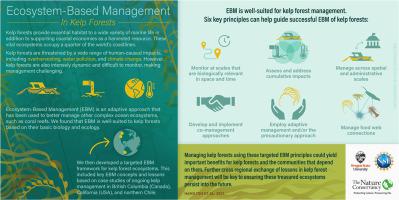Marine Policy ( IF 4.315 ) Pub Date : 2021-12-29 , DOI: 10.1016/j.marpol.2021.104919 Sara L. Hamilton 1 , Mary G. Gleason 2 , Natalio Godoy 3 , Norah Eddy 2 , Kirsten Grorud-Colvert 1

|
Kelp forests line a quarter of the world’s coastlines and provide diverse ecosystem services. While kelps are a harvested resource themselves, they are also foundation species that form the basis of productive ecosystems. Globally, kelps are threatened by a variety of anthropogenic impacts, including overharvesting, overgrazing, invasive species, poor water quality, and the direct and indirect effects of climate change. To address these threats and preserve the services provided by these foundation species, we show that Ecosystem-Based Management (EBM) approaches are well-suited for kelp forest management. To define and illustrate key EBM-inspired approaches for kelp forest management and conservation, we combined key concepts from the EBM literature, the literature on the biology and ecology of kelp forests, and primary information we gathered on case studies of ongoing kelp forest management at regional levels in British Columbia (Canada), California (United States), and northern Chile. Using these three sources of information, we identify six key principles for kelp forest EBM: 1) monitoring at biologically relevant temporal and spatial scales, 2) assessing and addressing cumulative impacts, 3) managing across spatial and institutional scales, 4) co-management with users, 5) employing rapid adaptive management and/or the precautionary principle, and 6) managing food web connections. We explore and illustrate these principles using examples from multiple regions to provide concrete guidance on EBM-inspired strategies that are likely to improve kelp forest management outcomes.
中文翻译:

基于生态系统的海带森林生态系统管理
海带森林分布在世界四分之一的海岸线上,提供多样化的生态系统服务。虽然海带本身是一种收获资源,但它们也是构成生产性生态系统基础的基础物种。在全球范围内,海带受到各种人为影响的威胁,包括过度捕捞、过度放牧、入侵物种、水质差以及气候变化的直接和间接影响。为了解决这些威胁并保护这些基础物种提供的服务,我们表明基于生态系统的管理 (EBM) 方法非常适合海带森林管理。为了定义和说明受 EBM 启发的海带森林管理和保护的关键方法,我们结合了 EBM 文献、海带森林生物学和生态学文献中的关键概念,以及我们收集的关于不列颠哥伦比亚省(加拿大)、加利福尼亚州(美国)和智利北部区域层面正在进行的海带森林管理案例研究的主要信息。使用这三个信息来源,我们确定了海带森林 EBM 的六个关键原则:1) 在生物相关的时间和空间尺度上进行监测,2) 评估和解决累积影响,3) 跨空间和制度尺度进行管理,4) 共同管理与用户,5) 采用快速适应性管理和/或预防原则,以及 6) 管理食物网连接。我们使用来自多个地区的例子来探索和说明这些原则,为可能改善海带森林管理成果的 EBM 启发战略提供具体指导。



























 京公网安备 11010802027423号
京公网安备 11010802027423号